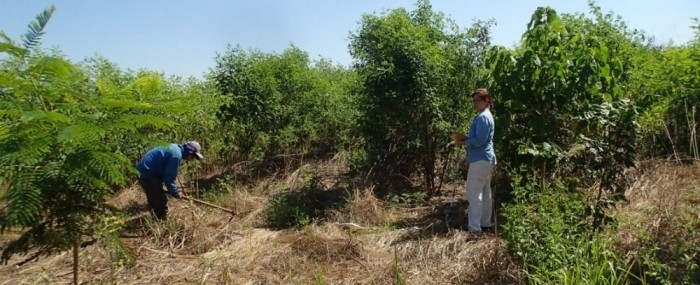
Brazilian firm develops more cost-effective forest restoration technologies
23 de janeiro de 2018By Suzel Tunes | FAPESP Research for Innovation – The Brazilian firm Bioflora, which will complete its twentieth year of existence in 2018, has participated in the development of several methodologies designed to rehabilitate degraded forest areas. According to agronomist André Gustavo Nave, the firm’s founder, ecological restoration technologies have changed considerably in recent decades. “Thirty years ago, no one was even concerned with using native species in reforestation,” he says. However, systematic comparisons for the purpose of identifying the most cost-effective methods have not been made.
To fill this gap, Bioflora developed a research project with the support of FAPESP’s Innovative Research in Small Business Program (PIPE).
The project sets out to evaluate 12 treatments involving different combinations of forest restoration methodologies. Tests have been performed in the municipalities of Iracemápolis, Santa Bárbara and Itu, São Paulo State, on private rural properties to which the owners granted access.
Preliminary results for PIPE Stage 1, completed in April 2017, show that direct seeding (planting directly into undisturbed soil) of native species is one of the most promising technologies, especially when pelleted (clay-coated) seeds are used.
The next step entails confirming this result and refining the seed coating process. “Our goal is to develop a mix of pelleted native seeds that will guarantee results for the rural proprietor,” Nave says.
Pelleting, he explains, consists of coating seeds with clay or another inert material and a water-soluble adhesive. Nutrients and pesticides can also be included in the pellet. In addition to making the seeds homogeneous, pelleting makes them larger and easier to sow. “Native seeds are very small. Some are as fine as powder, making it hard to use a planter. Pelleting facilitates regulation of the machine and ensures that the seeds drop in at the right depth,” Nave explains.
Pelleting is already used with vegetable seeds that are tiny. Refinement and popularization of the technique can stimulate the use of direct seeding and accelerate the forest restoration process, reducing costs.
“Direct seeding yields rapid results for a lower cost than planting seedlings of native species,” Nave says. “In two to three years, an initial forest is formed, with ecological functions such as protecting springs, providing animal habitats and filtering water.”
This restoration methodology uses two distinct groups of plant species: pioneer or cover species to structure the initial forest, followed by diversity species. The first stage consists of native shrubs that reach heights of up to 3 meters in only a year, providing shade and the environmental and soil conditions for the second stage, which consists of species that grow more slowly but consolidate the forest.
This methodology can also be associated with so-called “green fertilizing”, which entails planting leguminous shrubs and similar species that improve the soil conditions. “They fix nitrogen, decompact the soil and transform into organic matter,” Nave says. Used between the rows of pioneer native species planted for cover, green fertilizing also reduces infestation by grass and invasive plants, potentially reducing the frequency of mowing and weeding (mechanical, or chemical using herbicide) by 30%-40%, which therefore reduces the cost of maintaining the area.
Nave estimates that direct seeding associated with green fertilizing can reduce the cost of reforestation by as much as 70% compared with the cost of planting native species seedlings. However, more time is needed to evaluate the various combinations of techniques under different planting conditions. “We’ve applied for an extension to the project, and PIPE Stage 1 is now allowed to take a year,” he says.
The first stage showed that direct seeding works very well in some locations, Nave added. On steeply sloping land with clayey soil, however, productivity falls. He expects to solve the problem with pelleted seeds. “In this first stage, we succeeded in obtaining good preliminary results and, above all, identified the problems to be solved in the next stage,” he says.
Business-university partnership
To complete the first stage of the project, Nave worked with ten employees of Bioflora and engaged agricultural service firms that specialize in soil preparation. He also partnered with two professors at the University of São Paulo’s Luiz de Queiroz College of Agriculture (ESALQ-USP): Pedro Henrique Santin Brancalion in the Department of Forest Sciences and Ricardo Ribeiro Rodrigues in the Department of Biological Sciences. Rodrigues supervised his master’s degree in forest sciences and PhD in forest resources, both at ESALQ-USP.
Nave stresses the crucial importance of support from the university for the creation of Bioflora itself. “While I was an undergraduate, I participated in several forest restoration projects and worked as a service provider in collecting native seeds. I ended up starting the business while I was doing my master’s degree, and I’ve kept the link with ESALQ-USP ever since,” he recalls. As director of Bioflora, Nave participates in research projects in which he tests ideas born in the institution’s Ecology & Forest Restoration Laboratory (LERF), produces technical manuals in partnership with professors at the College, and is a member of panels of examiners for master’s students. “Now, I’ve rejoined the institution as a student: I’m taking a specialization course in soil management,” he says.
Company: Bioflora Tecnologia de Restauração
Site: viveirobioflora.com.br
Tels: +55 19 3414 2021 / 3414 4763
Contact: viveirobioflora.com.br/contato
